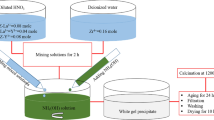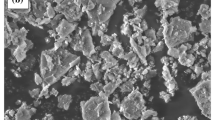Abstract
When studying nanoceramics, it is necessary to constantly keep in mind the closest interrelation of their fabrication method, structure, and properties. Nanoceramic materials are used in various branches of technology as structural and functional materials. Nanoceramics are also widely used in medicine. They are harmless, stable, and have great affinity to living organisms. ZrO2-based nanoceramics have a lower elastic modulus than other oxide materials. The specificity of their application lies in their high rupture strength, thermal shock resistance, and chemical stability at high temperatures. However, it is necessary to solve the problem of increasing the fracture toughness of ZrO2-based ceramic materials. The complex alloying of ZrO2 with yttrium and cerium oxides and the use of the Al2O3 additive leads to an increase in the fracture toughness and lowering of the negative effect of materials in the biological medium. In this work, the physicochemical properties of ceramic powders and materials of the ZrO2–2Y2O3–4CeO2–Al2O3 system synthesized by the chemical deposition of inorganic precursors when applying the sol-gel technology are considered based on scientific data and experimental studies. Alloying pure zirconium oxide by stabilizing Y2O3 and CeO2 oxides and thermal hardening of Al2O3 ensure the conservation of the tetragonal structure at room temperature, which makes it possible to retard and control the crack resistance of the material under the load. Investigations into the influence of the sintering temperature and aluminum oxide content on the microstructure and grain size, as well as physicomechanical properties of ceramic materials of compositions ZrO2–2Y2O3–4CeO2 + 1 wt % Al2O3 and ZrO2–2Y2O3–4CeO2 + 3 wt % Al2O3, are carried out.













Similar content being viewed by others
REFERENCES
Chevalier, J. and Gremillard, L., Ceramics for medical applications: A picture for the next 20 years, J. Eur. Ceram. Soc., 2009, pp. 1245–1255.
Shevchenko, A.V., Dudnik, E.V., Tsukrenko, V.V., and Ruban A.K., Microstructure design of materials in the ZrO2–Y2O3–CeO2–Al2O3 system, Poroshk. Metall., 2010, nos. 9/10, pp. 43–51.
Shevchenko, A.V., Hydrothermal synthesis of nanocrystalline powders in the ZrO2–Y2O3–CeO2 system, Poroshk. Metall., 2007, nos. 1/2, pp. 23–30.
Tsukrenko, V.V., Dudnik, E.V., Shevchenko, A.V, and Lopato, L.M., Hydrothermal synthesis of nanocrystalline powders in ZrO2–Y2O3–CeO2 system, in Collected Scientific Articles Sovremennye problemy fizicheskogo materialovedeniya (Modern Problems of Physical Materials Science), Kiev: IPM NAN Ukraine, 2008, no. 17, pp. 46–51.
Shevchenko, A.V., Dudnik, E.V., Ruban, A.K., Ked’ko, V.P., and Lopato, V.M., Synthesis and properties of nanocrystalline powder of the composition 90% ZrO2–Y2O3–CeO2 and 10% Al2O3, Neorg.Mater., 2008, vol. 44, no. 4, pp. 477–481.
Lashneva, V.V., Shevchenko, A.V., and Dudnik, E.V., Bioceramics based on ZrO2, Steklo Ceram., 2009, no. 4, pp. 25–28.
Chevalier, J., What future for zirconia as a biomaterial, Biomaterials, 2006, vol. 27, no. 4, pp. 535–543.
Palmero, P., Structural ceramic nanocomposites; a review of properties and powders’ synthesis methods, Nanomaterials, 2015, no. 5, pp. 656–696.
Porozova, S.E., Makarova, E.N., and Kul’met’eva, V.B., Effect of small Al2O3 additives on the properties of ceramics of the ZrO2–2Y2O3–4CeO2, Izv. Samar. Nauch. Tsentr. RAN, 2015, vol. 17, no. 2 (4), pp. 874–880.
Antsiferova, I.V. and Makarova, E.N., Effect of ultrasonic treatment and aging in ethanol medium on grain size distribution and agglomeration level of nanopowders of the ZrO2–2Y2O3–4CeO2–Al2O3 system, Perspekt. Mater., 2015, no. 1, pp. 41–48.
Makarova, E.N. and Antsiferova, I.V., Investigation into the solubility of nanopowders of the ZrO2–Y2O3–CeO2–Al2O3 system in the aqueous medium at various pH, Russ. J. Non-Ferrous Met., 2017, vol. 58, no. 5, pp. 525–529.
Kul’met’eva, V.B. and Porozova, S.E., Keramicheskie materialy: poluchenie, svoistva, primenenie (Ceramic Materials: Manufacturing, Properties, and Application), Perm: Perm Gos. Tekh. Univ., 2009, pp. 50–54.
Matrenin, S.V., Issledovanie svoistv oksidnoi keramiki na osnove ZrO2 i Al2O3: Metodicheskie ukazaniya po vypolneniyu laboratornykh rabot (Investigation into the Properties of Oxide Ceramics Based on ZrO2 and Al2O3: Study Guide for Laboratory Works), Tomsk: Tomsk Politekh. Univ., 2009.
Shevchenko, A.V., Ruban, A.K., and Dudnik, E.V., High-tech ceramics based on zirconium dioxide, Ogneupory Tekh. Keram., 2000, no. 9, pp. 2–8.
Bastide, B., Bastid, P., Canale, P., and Odie, P., Characterization of a new ternary Ce-tetragonal zirconia, J. Eur. Ceram. Soc., 1989, vol. 5, pp. 289–293.
Zhang, L., Zheng, Y., Guo, J., Wu, D., and Gong, M., Structure evolution process of Ce0.65Zr0.25Y0.1O1.95 prepared by oxidation–coprecipitation method, Acta Phys.-Chim. Sinica, 2008, vol. 24, no. 8, pp. 1342–1346. https://doi.org/10.1016/S0167-2738(98)00538-4
Volpato, C.A., Garbelotto, L.G. D., Fredel, M.C., and Bondioli, F., Application of zirconia in dentistry: biological, mechanical and optical considerations, advances in ceramics, in Electric and Magnetic Ceramics, Bioceramics, Ceramics and Environment, 2011, pp. 397–420.
Lin, J.-D. and Duh, J.-G., Correlation of mechanical properties and composition in tetragonal CeO2–Y2O3–ZrO2 ceramic system, Mater. Chem. Phys., vol. 78, pp. 246–252.
Shevchenko, A.V., Dudnik, E.V., Ruban, A.K., Red’ko, V.P., and Lopato, L.M., Effect of Al2O3 on the properties of nanocrystalline ZrO2 powder containing 3 mol % Y2O3, Neorg.Nanomater., 2010, vol. 46, no. 2, pp. 212–216.
Shevchenko, A.V., Lashneva, V.V., Dudnik, E.V., Ruban, A.K., and Podzorova, L.I., Synthesis and physicochemical properties of ceramics based on nanocrystalline powder of zirconia dioxide, Nanosist., Nanomater., Nanotekhnol., 2011, vol. 9, no. 4, pp. 881–893.
Lange, F.F., Transformation toughening. Pt. 4. Fabrication, fracture toughness and strength of Al2O3–ZrO2 composites, J. Mater. Sci., 1982, vol. 17, pp. 247–254.
Tsubakino, H., Nozato, R., and Hamamoto, M., Effect of alumina addition on the tetragonal-to-monoclinic phase transformation in zirconia–3 mol % yttria, J. Am. Ceram. Soc., 1991, vol. 74, no. 2, pp. 440–443.
Li, J. and Watanabe, R., Fracture toughness of Al2O3–particle-dispersed Y2O3 partially stabilized zirconia, J. Am. Ceram. Soc., 1995, vol. 78, no. 4, p. 1079–1082.
Author information
Authors and Affiliations
Corresponding authors
Additional information
Translated by N. Korovin
About this article
Cite this article
Makarova, E.N., Antsiferova, I.V. Physicochemical Processes of Fabricating Ceramic Materials Based on Nanopowders of Zirconium, Yttrium, Cerium, and Aluminum Oxides. Russ. J. Non-ferrous Metals 60, 745–753 (2019). https://doi.org/10.3103/S1067821219060129
Received:
Revised:
Accepted:
Published:
Issue Date:
DOI: https://doi.org/10.3103/S1067821219060129




